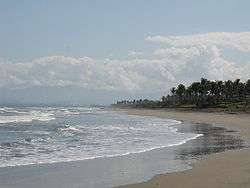Buguey, Cagayan
Buguey, officially the Municipality of Buguey (Ibanag: Ili nat Buguey; Ilocano: Ili ti Buguey; Tagalog: Bayan ng Buguey), is a 3rd class municipality in the province of Cagayan, Philippines. According to the 2015 census, it has a population of 30,175 people.[3]
Buguey | |
|---|---|
| Municipality of Buguey | |
 Beach at Buguey | |
 Seal | |
| Nickname(s): Crab Capital of the North | |
 Map of Cagayan with Buguey highlighted | |
OpenStreetMap 
| |
.svg.png) Buguey Location within the Philippines | |
| Coordinates: 18°17′18″N 121°49′59″E | |
| Country | |
| Region | Cagayan Valley (Region II) |
| Province | Cagayan |
| District | 1st District |
| Barangays | 30 (see Barangays) |
| Government | |
| • Type | Sangguniang Bayan |
| • Mayor | Lloyd M. Antiporda |
| • Vice Mayor | Licerio M. Antiporda III |
| • Congressman | Ramon C. Nolasco Jr. |
| • Electorate | 17,660 voters (2019) |
| Area | |
| • Total | 164.50 km2 (63.51 sq mi) |
| Population (2015 census)[3] | |
| • Total | 30,175 |
| • Density | 180/km2 (480/sq mi) |
| • Households | 6,689 |
| Economy | |
| • Income class | 3rd municipal income class |
| • Poverty incidence | 15.81% (2015)[4] |
| • Revenue (₱) | 92,723,881.76 (2016) |
| Time zone | UTC+8 (PST) |
| ZIP code | 3511 |
| PSGC | |
| IDD : area code | +63 (0)78 |
| Climate type | tropical monsoon climate |
| Native languages | Ibanag Ilocano Tagalog |
Barangays
Buguey is politically subdivided into 30 barangays.
- Ballang
- Balza
- Cabaritan
- Calamegatan
- Centro (Poblacion)
- Centro West
- Dalaya
- Fula
- Leron
- M.Antiporda
- Maddalero
- Mala Este
- Mala Weste
- Minanga Este
- Paddaya Este
- Pattao
- Quinawegan
- Remebella
- San Isidro
- Santa Isabel
- Santa Maria
- Tabbac
- Villa Cielo
- Alucao Weste (San Lorenzo)
- Minanga Weste
- Paddaya Weste
- San Juan
- San Vicente
- Villa Gracia
- Villa Leonora
Demographics
| Year | Pop. | ±% p.a. |
|---|---|---|
| 1903 | 3,433 | — |
| 1918 | 8,943 | +6.59% |
| 1939 | 14,293 | +2.26% |
| 1948 | 14,530 | +0.18% |
| 1960 | 20,475 | +2.90% |
| 1970 | 17,571 | −1.52% |
| 1975 | 19,926 | +2.55% |
| 1980 | 21,237 | +1.28% |
| 1990 | 22,889 | +0.75% |
| 1995 | 25,058 | +1.71% |
| 2000 | 26,401 | +1.13% |
| 2007 | 28,129 | +0.88% |
| 2015 | 30,175 | +0.88% |
| Source: Philippine Statistics Authority[3][5][6][7] | ||
In the 2015 census, the population of Buguey, Cagayan, was 30,175 people,[3] with a density of 180 inhabitants per square kilometre or 470 inhabitants per square mile.
Climate
| Climate data for Buguey, Cagayan | |||||||||||||
|---|---|---|---|---|---|---|---|---|---|---|---|---|---|
| Month | Jan | Feb | Mar | Apr | May | Jun | Jul | Aug | Sep | Oct | Nov | Dec | Year |
| Average high °C (°F) | 24 (75) |
26 (79) |
28 (82) |
31 (88) |
31 (88) |
31 (88) |
30 (86) |
30 (86) |
29 (84) |
28 (82) |
26 (79) |
25 (77) |
28 (83) |
| Average low °C (°F) | 21 (70) |
21 (70) |
21 (70) |
23 (73) |
24 (75) |
24 (75) |
24 (75) |
24 (75) |
24 (75) |
23 (73) |
23 (73) |
22 (72) |
23 (73) |
| Average precipitation mm (inches) | 150 (5.9) |
106 (4.2) |
84 (3.3) |
48 (1.9) |
103 (4.1) |
115 (4.5) |
134 (5.3) |
156 (6.1) |
136 (5.4) |
240 (9.4) |
246 (9.7) |
300 (11.8) |
1,818 (71.6) |
| Average rainy days | 19 | 14.3 | 12.8 | 10.8 | 17.7 | 18.9 | 21.5 | 23.3 | 22.1 | 20.4 | 20.3 | 22.2 | 223.3 |
| Source: Meteoblue [8] | |||||||||||||
gollark: C is an actual language.
gollark: I think the more powerful ones can run stuff like stripped-down Node.js or MicroPython.
gollark: You use C for those mostly.
gollark: It would probably have a microcontroller in it, and those typically run C.
gollark: There's probably some way to rewrite them as a bunch of equations, say, then solve those - you know the amount of X atom/ion on the left is equal to the amount on the right, and you know the amount on the left is equal to (moles of reactant A * 3 + moles of reactant B * 2) and so on.
References
- "Municipality". Quezon City, Philippines: Department of the Interior and Local Government. Retrieved 31 May 2013.
- "Province: Cagayan". PSGC Interactive. Quezon City, Philippines: Philippine Statistics Authority. Retrieved 12 November 2016.
- Census of Population (2015). "Region II (Cagayan Valley)". Total Population by Province, City, Municipality and Barangay. PSA. Retrieved 20 June 2016.
- "PSA releases the 2015 Municipal and City Level Poverty Estimates". Quezon City, Philippines. Retrieved 1 January 2020.
- Census of Population and Housing (2010). "Region II (Cagayan Valley)". Total Population by Province, City, Municipality and Barangay. NSO. Retrieved 29 June 2016.
- Censuses of Population (1903–2007). "Region II (Cagayan Valley)". Table 1. Population Enumerated in Various Censuses by Province/Highly Urbanized City: 1903 to 2007. NSO.
- "Province of Cagayan". Municipality Population Data. Local Water Utilities Administration Research Division. Retrieved 17 December 2016.
- "Buguey, Cagayan: Average Temperatures and Rainfall". Meteoblue. Retrieved 3 November 2018.
External links
This article is issued from Wikipedia. The text is licensed under Creative Commons - Attribution - Sharealike. Additional terms may apply for the media files.